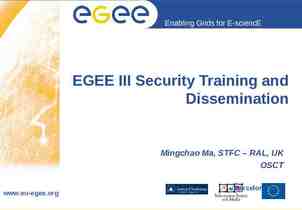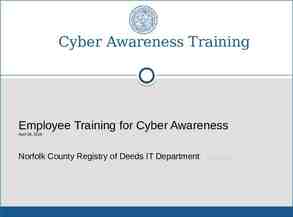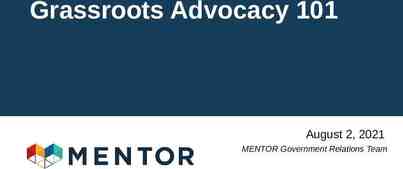A WEBINAR ON NATIONAL EDUCATION POLICY-2020 By SIVA REDDY
58 Slides4.43 MB

A WEBINAR ON NATIONAL EDUCATION POLICY-2020 By SIVA REDDY SONTI ASSISTANT PROFESSOR OF ECE G.PULLA REDDY COLLEGE(Autonomous) KURNOOL ENGINEERING

What is the need of NEP2020 The famous statement of Nelson Mandela is displayed at the entrance of the University of South Africa thus: "Destroying any nation does not require the use of atomic bombs or the use of long-range missiles. It only requires lowering the quality of education and allowing cheating in the examinations by the students." A WEBINAR ON NEP-2020 @ GPREC,KURNOOL

IMPORTANCE OF EDUCATION A WEBINAR ON NEP-2020 @ GPREC,KURNOOL

1.What does Education Policy mean? Education policy refers to the collection of laws and rules that govern the operation of education systems. 2.Why is it important to study education policy? Policies are important because they help a school/college to establish rules and procedures and create standards of quality for learning and safety, as well as expectations and accountability. Without EDUCATION POLICY, educational institute would lack the structure and unable to meet the needs of students. A WEBINAR ON NEP-2020 @ GPREC,KURNOOL

3.What is the role of policy in education? Policies are important because they help a school/college to establish rules and procedures in order to function effectively and ensure everyone is connected. Schools/Colleges create standards of quality for learning and safety, as well as expectations and accountability 4. What are the features of educational policy? The main characteristics reviewed are problems caused by the intangibility of many educational goals, the inconsistency of educational goals; priority ordering of goals and weighting of educational goals; and the cost of goals. A WEBINAR ON NEP-2020 @ GPREC,KURNOOL

Two notable observations from supreme court of India 1.”Toadays education failed to reform human behavior “ and 2.”With increase in literacy level , There is decline in human values in the society” . Hence call for transformation in education system The Union cabinet in July 2020 approved the New Education Policy (NEP), which aims at universalization of education from pre-school to secondary level. A WEBINAR ON NEP-2020 @ GPREC,KURNOOL

A WEBINAR ON NEP-2020 @ GPREC,KURNOOL

A WEBINAR ON NEP-2020 @ GPREC,KURNOOL

A WEBINAR ON NEP-2020 @ GPREC,KURNOOL

A WEBINAR ON NEP-2020 @ GPREC,KURNOOL

HIGHLIGHTS OF THE NEP 2020 The new policy aims for universalization of education from pre-school to secondary level with 100 per cent Gross Enrolment Ratio (GER) in school education by 2030 and aims to raise GER in higher education to 50 per cent by 2025. NEP 2020 will bring two crore out of school children back into the main stream. The 10 2 structure of school curricula is to be replaced by a 5 3 3 4 curricular structure corresponding to ages 3-8, 8-11, 11-14, and 14-18 years respectively. It will include 12 years of schooling and three 3 of Anganwadi and preschooling. A WEBINAR ON NEP-2020 @ GPREC,KURNOOL

National Education Policy-2020 Reinventing the school education Age 3-8 (5) A WEBINAR ON NEP-2020 @ GPREC,KURNOOL Age 8-11 (3) Age 11-14(3) Age 14-18 (4)

A WEBINAR ON NEP-2020 @ GPREC,KURNOOL

HIGHLIGHTS OF NEP2020 NCERT will develop NCPFECCE i.e. National Curricular and Pedagogical Framework for Early Childhood Care and Education for children up to the age of 8. A National Book Promotion Policy is to be formulated. All students will take school examinations in Grades 3, 5, and 8 which will be conducted by the appropriate authority. Board exams for Grades 10 and 12 will be continued, but redesigned with holistic development as the aim. A WEBINAR ON NEP-2020 @ GPREC,KURNOOL

A WEBINAR ON NEP-2020 @ GPREC,KURNOOL

A WEBINAR ON NEP-2020 @ GPREC,KURNOOL

A WEBINAR ON NEP-2020 @ GPREC,KURNOOL

A WEBINAR ON NEP-2020 @ GPREC,KURNOOL

Emotional growth of the child. A WEBINAR ON NEP-2020 @ GPREC,KURNOOL

A WEBINAR ON NEP-2020 @ GPREC,KURNOOL

Curtailing Dropout Rates and Ensuring Universal Access to Education at All Levels One of the primary goals of the schooling system must be to ensure that children are enrolled in and are attending school. India has made remarkable strides in recent years in attaining nearuniversal enrolment in elementary education. However, the data for later grades indicates some serious issues in retaining children in the schooling system. The GER for Grades 68 was 90.9%, while for Grades 9-10 and 11-12 it was only 79.3% and 56.5%, respectively - indicating that a significant proportion of enrolled students drop out after Grade 5 and especially after Grade 8. A WEBINAR ON NEP-2020 @ GPREC,KURNOOL

As per the 75th round household survey by NSSO in 2017-18, the number of out of school children in the age group of 6 to 17 years is 3.22 crore. It will be a top priority to bring these children back into the educational fold as early as possible, and to prevent further students from dropping out, with a goal to achieve 100% Gross Enrolment Ratio in preschool to secondary level by 2030. CURRICULUM AND PEDAGOGY IN SCHOOLS: Learning Should be Holistic, Integrated, Enjoyable, and Engaging Restructuring school curriculum and pedagogy in a new 5 3 3 4 design for cognitive development of the children. A WEBINAR ON NEP-2020 @ GPREC,KURNOOL

A WEBINAR ON NEP-2020 @ GPREC,KURNOOL

A WEBINAR ON NEP-2020 @ GPREC,KURNOOL

A WEBINAR ON NEP-2020 @ GPREC,KURNOOL

Holistic development of learners The key overall thrust of curriculum and pedagogy reform across all stages will be to move the education system towards real understanding and towards learning how to learn - and away from the culture of rote learning as is largely present today. The aim of education will not only be cognitive development, but also building character and creating holistic and well-rounded individuals equipped with the key 21st century skills. Specific sets of skills and values across domains will be identified for integration and incorporation at each stage of learning, from pre-school to higher education. A WEBINAR ON NEP-2020 @ GPREC,KURNOOL

Reduce curriculum content to enhance essential learning and critical thinking Curriculum content will be reduced in each subject to its core essentials, to make space for critical thinking and more holistic, inquiry-based, discovery-based, discussion-based, and analysis based learning. The mandated content will focus on key concepts, ideas, applications, and problem solving. Teaching and learning will be conducted in a more interactive manner; questions will be encouraged, and classroom sessions will regularly contain more fun, creative, collaborative, and exploratory activities for students for deeper and more experiential learning. A WEBINAR ON NEP-2020 @ GPREC,KURNOOL

A WEBINAR ON NEP-2020 @ GPREC,KURNOOL

Empower students through flexibility in course choices Students will be given increased flexibility and choice of subjects to study, particularly in secondary school - including subjects in physical education, the arts and crafts, and vocational skills – so that they can design their own paths of study and life plans. Holistic development and a wide choice of subjects and courses year to year will be the new distinguishing feature of secondary school education. There will be no hard separation among ‘curricular’, ‘extracurricular ’, or ‘co-curricular’, among ‘arts’, ‘humanities’, and ‘sciences’, or between ‘vocational’ or ‘academic’ streams. Subjects such as physical education, the arts and crafts, and vocational skills, in addition to science, humanities, and mathematics, will be incorporated throughout the school curriculum, with a consideration for what is interesting and safe at each age. A WEBINAR ON NEP-2020 @ GPREC,KURNOOL

NEP 2020 A WEBINAR ON NEP-2020 @ GPREC,KURNOOL

A WEBINAR ON NEP-2020 @ GPREC,KURNOOL

A WEBINAR ON NEP-2020 @ GPREC,KURNOOL

Some of the major problems currently faced by the higher education system in India include (a) a severely ecosystem; (b) less emphasis on the development of cognitive skills and learning outcomes; (c) a rigid separation of disciplines, with early specialization and streaming of students into narrow areas of study; (d) limited access particularly in socio-economically disadvantaged areas, with few HEIs that teach in local languages A WEBINAR NEP-2020 @ GPREC,KURNOOL (e)ONlimited teacher fragmented higher educational and institutional autonomy.

(f) inadequate mechanisms for merit-based career management and progression of faculty and institutional leaders. (g) lesser emphasis on research at most universities and colleges, and lack of competitive peer reviewed research funding across disciplines; (h) suboptimal governance and leadership of HEIs (i) an ineffective regulatory system; and (j) large affiliating universities resulting in low standards of undergraduate education. A WEBINAR ON NEP-2020 @ GPREC,KURNOOL

The policy’s vision includes the following key changes to the current system: (a) moving towards a higher educational system consisting of large, multidisciplinary universities and colleges, with at least one in or near every district, and with more HEIs across India that offer medium of instruction or programms in local/Indian languages; (b) moving towards a more multidisciplinary undergraduate education; (c) moving towards faculty and institutional autonomy; (d) revamping curriculum, pedagogy, assessment, and student support for enhanced student experiences; A WEBINAR ON NEP-2020 @ GPREC,KURNOOL

(e) reaffirming the integrity of faculty and institutional leadership positions through merit appointments and career progression based on teaching, research, and service; (f) Establishment of a National Research Foundation to fund outstanding peer-reviewed research and to actively seed research in universities and colleges; (g) governance of HEIs by high qualified independent boards having academic and administrative autonomy; (h) “light but tight” regulation by a single regulator for higher education; (i) increased access, equity, and inclusion through a range of measures, including greater opportunities for outstanding public education; scholarships by private/philanthropic universities for disadvantaged and underprivileged students; online education, and Open Distance Learning (ODL); and all A WEBINAR ON NEP-2020 @ GPREC,KURNOOL infrastructure and learning materials accessible and available to learners with disabilities

A WEBINAR ON NEP-2020 @ GPREC,KURNOOL

A WEBINAR ON NEP-2020 @ GPREC,KURNOOL

A WEBINAR ON NEP-2020 @ GPREC,KURNOOL

A WEBINAR ON NEP-2020 @ GPREC,KURNOOL

A WEBINAR ON NEP-2020 @ GPREC,KURNOOL

A WEBINAR ON NEP-2020 @ GPREC,KURNOOL

A WEBINAR ON NEP-2020 @ GPREC,KURNOOL

A WEBINAR ON NEP-2020 @ GPREC,KURNOOL

NEW INSTITUTIONAL ARCHITECTURE The main thrust of this policy in higher education is to end the fragmentation of higher education by transforming higher education institutions into large multidisciplinary universities, colleges, and HEI clusters, each of which will aim to have 3,000 or more students. It is envisioned that over a period of time all existing HEIs and new HEIs will evolve into research-intensive universities (RUs), teaching universities (TUs), and autonomous degree-granting colleges (ACs). This would require mapping existing HEIs in a rationalised manner to achieve the new institutional architecture for higher education. A WEBINAR ON NEP-2020 @ GPREC,KURNOOL

A WEBINAR ON NEP-2020 @ GPREC,KURNOOL

A WEBINAR ON NEP-2020 @ GPREC,KURNOOL

A WEBINAR ON NEP-2020 @ GPREC,KURNOOL

A WEBINAR ON NEP-2020 @ GPREC,KURNOOL

A WEBINAR ON NEP-2020 @ GPREC,KURNOOL

The Centre and the States will work together to increase the public investment in Education sector to reach 6 per cent of GDP at the earliest. A WEBINAR ON NEP-2020 @ GPREC,KURNOOL

Advantages of New Education Policy 2020 The Government aims to make schooling available to everyone with the help of NEP 2020. Approximately two crore school students will be able to come back to educational institutes through this new approach. For children up to the age of 8, a National Curricular and Pedagogical Framework for Early Childhood Care and Education will be designed and developed by NCERT. One of the merits of NEP 2020 is the formation of National Book promotion Policy in India. Appropriate authorities will conduct the school examinations for grades 3, 5 and 8. The board exams for grades 10 and 12 will continue but the NEP 2020 aims to re-design the structure with holistic development. A WEBINAR ON NEP-2020 @ GPREC,KURNOOL

This new plan focuses on setting up a Gender Inclusion Fund. Special Education Zones for disadvantaged regions and groups is also in the focused list. Special daytime boarding school “Bal Bhavans” to be established in every state/ district in India. This boarding school will be used for participation in activities related to play, career, art. By 2022, in consultation with teachers and expert organizations, NCERT, SCERTs, the National Council for Teacher Education will develop a common National Professional Standards for Teachers (NPST). SSSA or independent State School Standards Authority will be set up by the states/ UTs. According to the national education policy 2020, an Academic Bank of Credit will be established. The credits earned by the students can be stored and when the final degree gets completed, those can be counted. A WEBINAR ON NEP-2020 @ GPREC,KURNOOL

Multidisciplinary Education and Research Universities at par with the IITs and IIMs will be set up in the country. These are scheduled to be set up for introducing multidisciplinary academic. The same list of accreditation and regulation rules will be used for guiding both the public and private academic bodies. Phased out college affiliation and autonomy will be granted to colleges. By the year 2030, it will be mandatory to have at least a four year B. Ed degree for joining the occupation of teaching. For making the students prepared for future pandemic situations, online academic will be promoted on a larger scale. A WEBINAR ON NEP-2020 @ GPREC,KURNOOL

Drawbacks of the New Education Policy In the National Education Policy 2020, language is a negative factor as there is a problematic teacher to student ratio in India, thus introducing mother languages for each subject in academic institutes is a problem. Sometimes, finding a competent teacher becomes a problem and now another challenge comes with the introduction of the NEP 2020, that is bringing study material in mother languages. According to the national education policy 2020, students willing to complete their graduation have to study for four years while one can easily complete his/ her diploma degree in two years. This might encourage the pupil to leave the course midway. A WEBINAR ON NEP-2020 @ GPREC,KURNOOL

According to the national education policy 2020, students of the private schools will be introduced with English at a much earlier age than the students of the Government schools. The academic syllabus will be taught in the respective regional languages of the Government school students. This is one of the major new education policy drawbacks as this will increase the number of students uncomfortable in communicating in English thus widening the gap between sections of the societies. A WEBINAR ON NEP-2020 @ GPREC,KURNOOL

CONCLUSION With the introduction of NEP 2020, many changes have been made and one of those is the discontinuation of M. Phil course. Even though there are many drawbacks in the new education policy, the merits are more in number. It is believed by many that by implementing these changes, the Indian academic system will be taken a step higher. A WEBINAR ON NEP-2020 @ GPREC,KURNOOL

A WEBINAR ON NEP-2020 @ GPREC,KURNOOL






